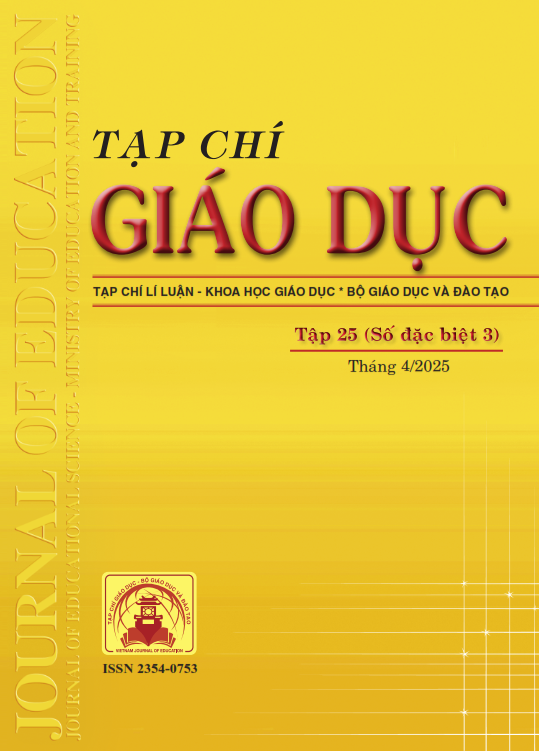Khung lí thuyết đánh giá mức độ sẵn sàng áp dụng lớp học đảo ngược của giáo viên
- Từ khóa:
- Flipped classroom
- readiness
- technology adoption
- TA
- CBA
- TRA
- TPB
Tóm tắt
The advancement of technology and the lifelong learning trend have placed an urgent demand on teachers to innovate teaching methods, techniques, and instructional models. In this context, the flipped classroom (FC) is regarded as an effective approach for enhancing learner autonomy. This study identifies and analyzes theoretical frameworks suitable for assessing teachers' readiness to adopt the flipped classroom model, using a theoretical synthesis method. Several important theoretical models are reviewed, including the Technology Acceptance Model (TAM), the Concerns-Based Adoption Model (CBAM), the Theory of Reasoned Action (TRA), and the Theory of Planned Behavior (TPB). A significant contribution of this research is the proposal of a theoretical framework for evaluating teachers' readiness, emphasizing key factors such as perceived usefulness, technological skills, attitudes, and behavioral intentions. Based on this framework, recommendations are provided to ensure scientific validity and reliability when constructing readiness assessment tools. The research findings contribute practical value by providing both a theoretical foundation and a practical instrument to facilitate teachers' effective implementation of the flipped classroom.
Tài liệu tham khảo
Ajzen, I. (1991). The theory of planned behavior. Organizational Behavior and Human Decision Processes, 50(2), 179-211. https://doi.org/10.1016/0749-5978(91)90020-T
Anderson, S. (2002). Understanding teacher change: Revisiting the concerns-based adoption model. Curriculum Inquiry, 27(3), 331-367. https://doi.org/10.1111/0362-6784.00057
Davis, F. D., Bagozzi, R. P., & Warshaw, P. R. (1989). User acceptance of computer technology: A comparison of two theoretical models. Management Science, 35(8), 982-1003. http://dx.doi.org/10.1287/mnsc.35.8.982
Doo, M. Y. (2023). An investigation of the social influence processes of flipped class students: An application of the extension of the technology acceptance model. Education and Information Technologies, 28, 16593-16613. https://doi.org/10.1007/s10639-023-11878-3
Fishbein, M., & Ajzen, I. (1975). Belief, attitude, intention, and behavior: An introduction to theory and research. Addison-Wesley.
Fuller, F. F. (1969). Concerns of teachers: A developmental conceptualization. American Educational Research Journal, 6(2), 207-226.
Gilboy, M. B., Heinerichs, S., & Pazzaglia, G. (2015). Enhancing student engagement using the flipped classroom. Journal of Nutrition Education and Behavior, 47(1), 109-114. https://doi.org/10.1016/j.jneb.2014.08.008
Hall, G. E., George, A. A., & Rutherford, W. L. (1979). Measuring stages of concern about the innovation: A manual for use of the SoC questionnaire. University of Texas at Austin.
Hall, G. E., & Hord, S. M. (1987). Change in schools: Facilitating the process. Sunny Press.
Hord, S. M., Rutherford, W. L., Huling, L., & Hall, G. E. (1987). Taking charge of change. ASCD.
Lo, C. K., & Hew, K. F. (2017). A critical review of flipped classroom challenges in K-12 education: Possible solutions and recommendations for future research. Research and Practice in Technology Enhanced Learning, 12, 1-22. https://doi.org/10.1186/s41039-016-0044-2
Marsh, C. J., & Willis, G. (2007). Curriculum: Alternative approaches, ongoing issues (4th ed.). Merrill Prentice Hall.
Salaberri Ramiro, M. S., & Crúz Martínez, M. S. (2020). Integrating flipped foreign language learning through mobile devices: Technology acceptance and flipped learning experience. Sustainability, 12(13), 5347. https://doi.org/10.3390/su12031110
Trần Thị Hương Xuân, Nguyễn Bảo Hoàng Thanh, Nguyễn Thị Nhị (2023). Các yếu tố ảnh hưởng đến ý định sử dụng mô hình “lớp học đảo ngược” trong dạy học của giáo viên: Nghiên cứu tại khu vực miền Trung, Tây Nguyên và Nam Bộ. Tạp chí Giáo dục, 23(4), 37-44.
Đã Xuất bản
Cách trích dẫn
Số
Chuyên mục
Giấy phép

Tác phẩm này được cấp phép theo Ghi nhận tác giả của Creative Commons Giấy phép quốc tế 4.0 .












